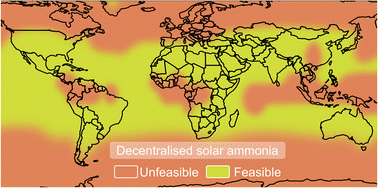Environmental and economic potential of decentralised electrocatalytic ammonia synthesis powered by solar energy†
Abstract
Intense efforts have been devoted to developing green and blue centralised Haber–Bosch processes (gHB and bHB, respectively), but the feasibility of a decentralised and more sustainable scheme has yet to be assessed. Here we reveal the conditions under which small-scale systems (NH3-leaves) based on the electrocatalytic reduction of nitrogen (eN2R) powered by photovoltaic energy could realise a decentralised scheme competitive in terms of environmental and economic criteria. For this purpose, we calculated energy efficiency targets worldwide, providing clear values that may guide research in the incipient eN2R field. Even at this germinal stage, the NH3-leaf technology would compete favourably in sunny locations for CO2-related Earth-system processes and human health relative to the business-as-usual production scenario. Moreover, a modest 8% gain in energy efficiency would already make them outperform the gHB in terms of climate change-related impacts in the sunniest locations. If no CO2 taxation is enforced, the lowest estimated ammonia production cost would be 3 times the industrial standard, with the potential to match it provided a substantial decrease of investment costs and very high selectivity toward ammonia in eN2R are achieved. The disclosed sustainability potential of NH3-leaf makes it a strong ally of gHB toward defossilised ammonia production.

- This article is part of the themed collection: Recent Open Access Articles


 Please wait while we load your content...
Please wait while we load your content...